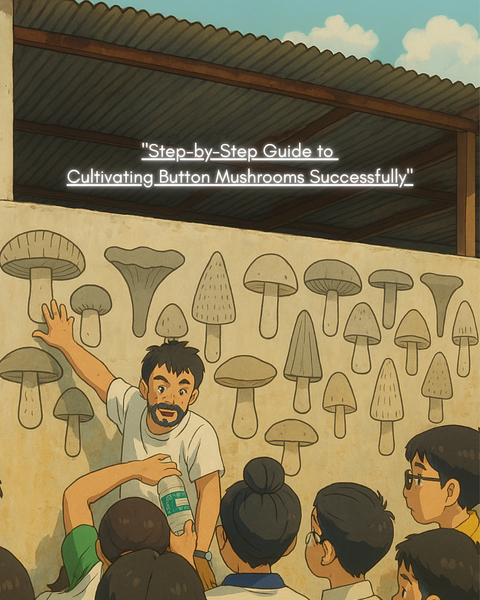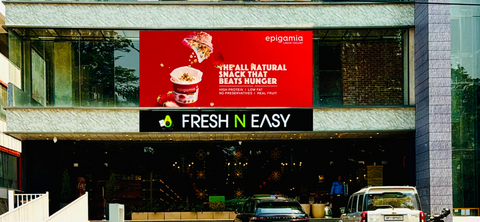Each step in cultivating button mushrooms is crucial, and understanding when and how to implement them makes all the difference. This article outlines the seasonal cultivation process in detail.
1. Preparation of Compost
To prepare compost for button mushrooms, the base materials required are wheat straw, sugarcane bagasse, and mustard straw (sarso ki tudi). Since we are focusing on seasonal cultivation, we will follow the long method of composting.

Steps in Compost Preparation:
a. Wetting the Substrate (Wheat Straw):
Soak the wheat straw for 5–6 days to ensure proper moisture absorption.
b. Mixing the Materials:
After soaking, spread the substrate on the floor and add all other raw materials over it. Mix thoroughly to create a good-quality compost base.
c. Heap Formation:
Once mixed, form a heap approximately 4 to 5 feet high. This helps raise the internal temperature to 58–60°C, promoting microbial activity. Ensure proper aeration so that aerobic fermentation can occur.

d. Turning (Palti):
The first heap formation is called the 0th palti. Every 48 hours, the substrate must be turned to form a new heap — this process is called palti.
-
Total: 12 paltis
-
First 6–8 paltis: Promote aerobic microbial activity.
-
Next 2 paltis: Eliminate pathogens.
-
Last 2 paltis: Release excess ammonia and bring down the temperature to 30°C.
-
2. Spawning
Once composting is complete (after all 12 paltis), ensure the temperature has dropped to 30°C. Break the heap, spread the compost on the floor, sprinkle spawn over it, mix well, and fill bags of 10 kg each.
3. Top Spawning
Place all filled bags inside the spawn run room. Sprinkle a layer of spawn on top of each bag and tie the bags tightly to initiate the spawn run.
4. Mycelium Run
Keep the bags sealed for 11–12 days to allow for the spawn run. During this period, the mycelium will spread throughout the compost. The appearance of yellow moisture droplets on the inner surface of the bag indicates a successful spawn run and readiness for casing.

5. Casing
After a successful mycelium run, open all the bags and apply a 2-inch layer of casing soil over the compost. Then wrap or seal the bags again.

6. Ruffling
Wait 5–6 days after casing until mycelium starts to spread over the casing layer. Once it does:

-
Open the bags.
-
Cut excess polythene or roll it down.
-
Gently scratch the top 1 inch of casing soil to allow mycelium to spread more evenly.
-
Cover the bags with moist newspaper, watering daily to maintain humidity.

7. Covering
After 4–5 days, when the casing layer is fully colonized (white with mycelium), it's time for covering.
-
Sprinkle a thin layer of casing soil to cover the mycelium.
-
Reduce the temperature to 16°C to initiate fruiting.
8. Pinning and Pinning Covering
Maintain humidity by sprinkling water on each bag for 6 days. Around the 10th to 12th day, pinning (small mushroom heads) will appear.
To protect the pins from excess moisture:
-
Lightly cover them with casing soil.
9. Harvesting - First Flush
From the day of covering, it typically takes 14–15 days for mushrooms to fully mature.
-
Harvest when mushrooms reach the right size.
-
After each harvest, fill holes with casing soil and maintain hygiene.
-
The first flush lasts 4–6 days, yielding around 50% of the total harvest.
After the first flush:
-
Clean bags.
-
Cover all holes with casing soil.
-
Allow 3–4 days for the next pinning.
10. Harvesting - Second & Third Flush
After the 3–4 day rest, the second flush will begin as new mushrooms emerge.
-
The remaining 50% of the yield will be harvested across the second and third flushes.
Once all flushes are complete:
-
Remove the spent compost.
-
Sell it as organic manure to local farmers.
-
Clean the grow room thoroughly for the next cycle.
Environmental Conditions
Temperature:
| Stage | Temperature |
|---|---|
| Spawning to Covering | 24–26°C |
| Covering to Pinning | 16°C |
| Harvesting | 16–17°C |
CO₂ Levels:
| Stage | CO₂ Concentration |
|---|---|
| Spawning to Covering | 10,000 ppm and above |
| Pinning Generation | 1,500 ppm |
| Harvesting | 800–1,200 ppm |
This structured approach ensures a successful seasonal cultivation of button mushrooms with high-quality yield and minimal spoilage. For best results, maintain hygiene, monitor temperature and CO₂ levels regularly, and follow each step diligently.
THE ABOVE PICTURES AND VIDEO ARE USED IN THIS BLOG ARE TAKEN FROM JAAIVAT INDIA MUSHROOM FARM.







Comments (0)
There are no comments for this article. Be the first one to leave a message!